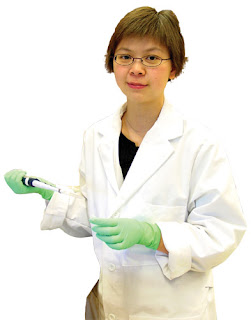Graphene, a one-atom-thick layer of a carbon lattice with a honeycomb structure, has great potential for use in radios, computers, phones and other electronic devices. But applications have been stymied because the semi-metallic graphene, which has a zero band gap, does not function effectively as a semiconductor to amplify or switch electronic signals.
While cutting graphene sheets into nanoscale ribbons can open up a larger band gap and improve function, 'nanoribbon' devices often have limited driving currents, and practical devices would require the production of dense arrays of ordered nanoribbons — a process that so far has not been achieved or clearly conceptualized.
The nanomesh can have variable periodicities, defined as the distance between the centers of two neighboring nanoholes. Neck widths, the shortest distance between the edges of two neighboring holes, can be as low as 5 nanometers.
This ability to control nanomesh periodicity and neck width is very important for controlling electronic properties because charge transport properties are highly dependent on the width and the number of critical current pathways.
Using such nanomesh as the semiconducting channel, Huang and her team have demonstrated room-temperature transistors that can support currents nearly 100 times greater than individual graphene nanoribbon devices, but with a comparable on-off ratio. The on-off ratio is the ratio between the currents when a device is switched on or switched off. This usually reveals how effectively a transistor can be switched off and on.
The researchers have also shown that the on-off ratio can be tuned by varying the neck width.
"GNMs can address many of the critical challenges facing graphene, as well as bypass the most challenging assembly problems," Huang said. "In conjunction with recent advances in the growth of graphene over a large-area substrate, this concept has the potential to enable a uniform, continuous semiconducting nanomesh thin film that can be used to fabricate integrated devices and circuits with desired device size and driving current.
"The concept of the GNM therefore points to a clear pathway towards practical application of graphene as a semiconductor material for future electronics. The unique structural and electronic characteristics of the GNMs may also open up exciting opportunities in highly sensitive biosensors and a new generation of spintronics, from magnetic sensing to storage," she said. ###
The study was funded in part by Huang's UCLA Henry Samueli School of Engineering and Applied Science Fellowship.
The UCLA Henry Samueli School of Engineering and Applied Science, established in 1945, offers 28 academic and professional degree programs, including an interdepartmental graduate degree program in biomedical engineering. Ranked among the top 10 engineering schools at public universities nationwide, the school is home to seven multimillion-dollar interdisciplinary research centers in wireless sensor systems, nanotechnology, nanomanufacturing and nanoelectronics, all funded by federal and private agencies.
For more news, visit the UCLA Newsroom and follow us on Twitter.
Contact: Wileen Wong Kromhout wwkromhout@support.ucla.edu 310-206-0540 University of California - Los Angeles















No comments:
Post a Comment